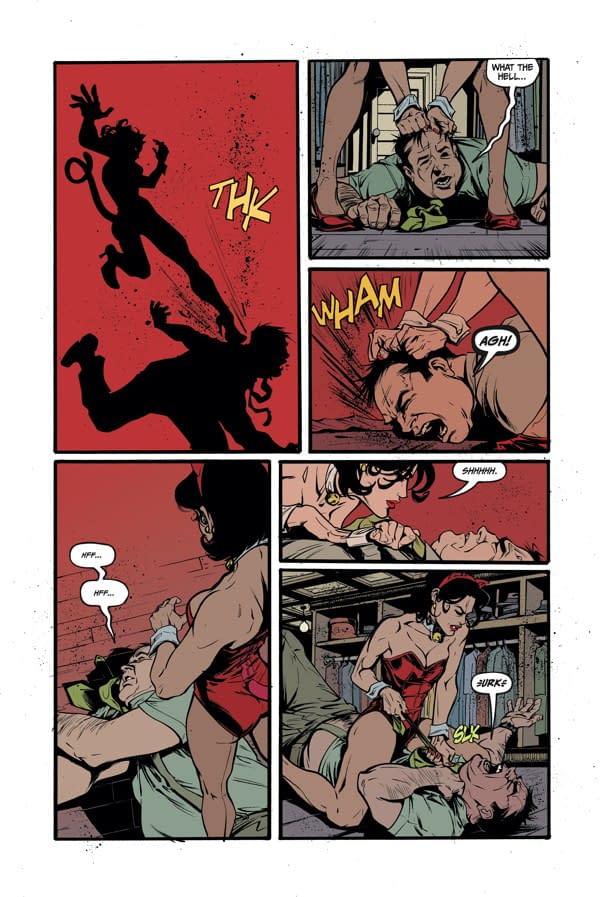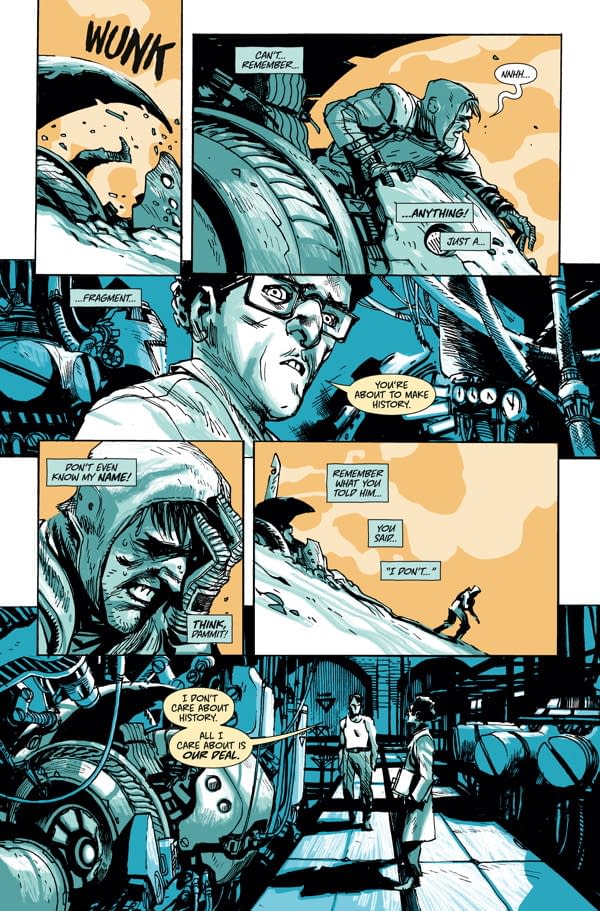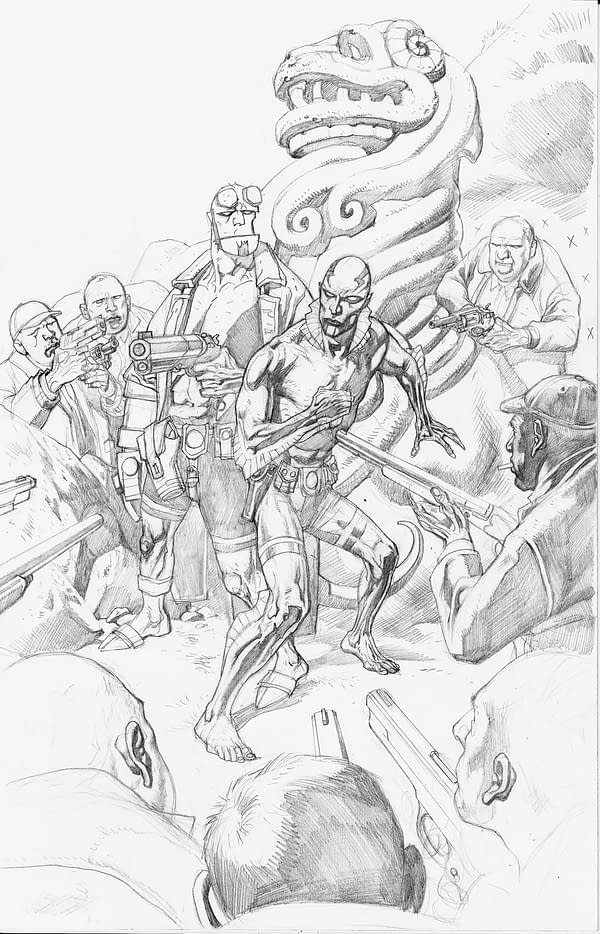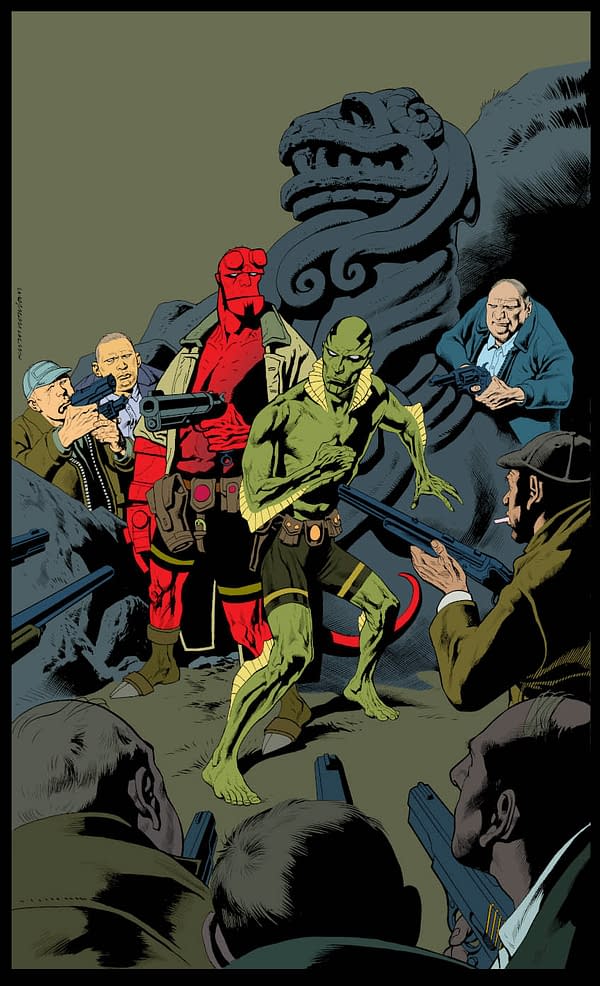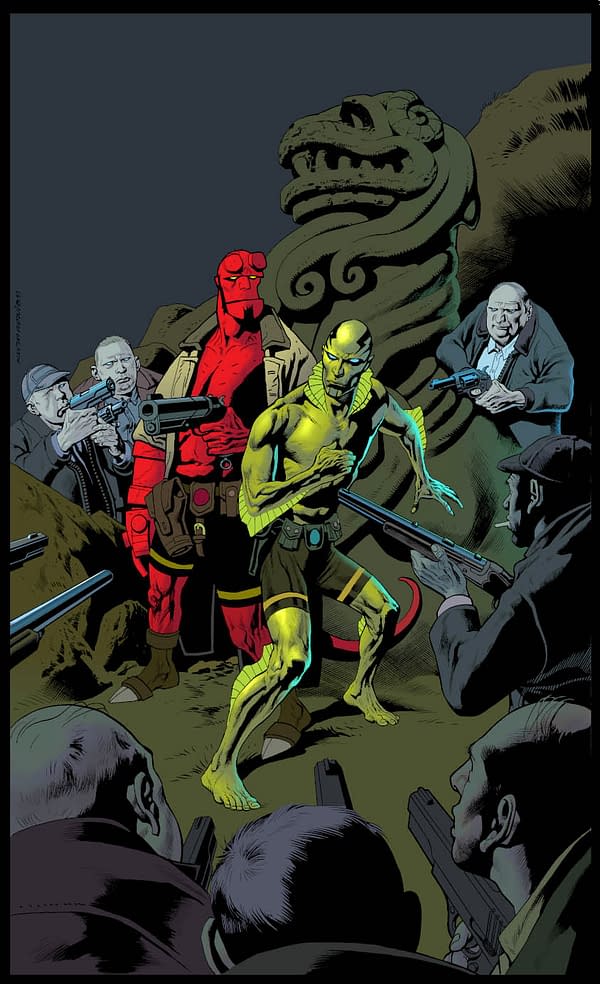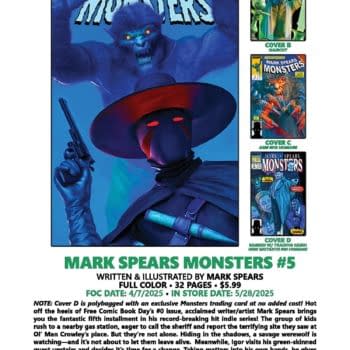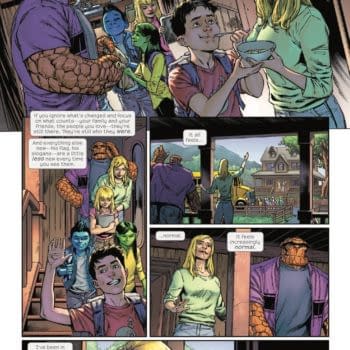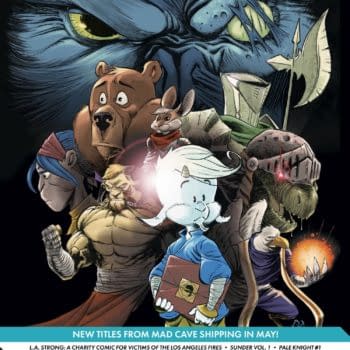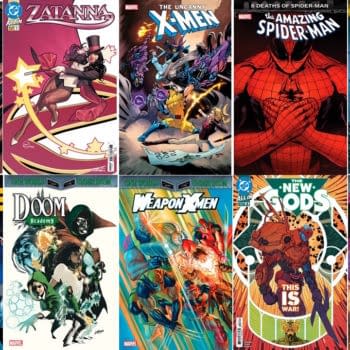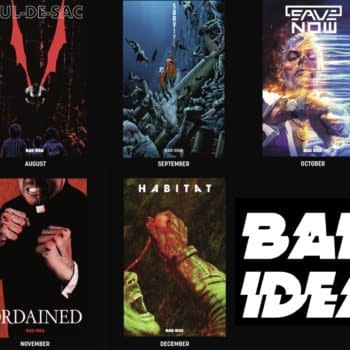Posted in: Comics, Recent Updates | Tagged: baltimore, brian wood, cameron stewart, chuck palahniuk, Comics, dark horse comics, entertainment, eric powell, Fight Club 2, Frankenstein Underground, matt kindt, mike mignola, Past Aways, Rafael Albuquerque, rebels, scott allie, The Cult of the Red King, the goon
Discussions With Scott Allie – Fight Club2 Release Date, Frankenstein Underground, Lady Killer, Past Aways, Ei8ht, The Goon, Rebels, Rat God, And Even More (UPDATE)

Who better to discuss them with us than Dark Horse Editor-in-Chief Scott Allie? He's been spending plenty of time developing Fight Club 2 with writer Chuch Palahniuk and artist Cameron Stewart, but at this moment, with Lady Killer by Joelle Jones and Jamie S. Rich having sold out in first and second issues, that's at the forefront of conversation.
Scott Allie joins us today to talk about Lady Killer, "retro" comics, Fight Club 2, Ei8ht, The Goon: Once Upon a Hard Time, Past Aways, Rebels, Rat God, Abe Sapien #23, Frankenstein Underground, Hellboy in Hell and Baltimore: The Cult of the Red King as well as what makes a comic a Dark Horse book in terms of simply being a comic that couldn't be created by anyone else.

Scott Allie: Well, I spent so much time getting Fight Club ready for 2015, now I'm reminded of the bigger picture and how many great new series we have rolling out. Like Lady Killer, which is near and dear to my heart. I've been friends with Joelle Jones for a long time, and Lady Killer is that great book where an incredibly talented artist figured out how to throw all her favorite stuff together in one story. She's worked with Jamie Rich for years, usually with Jamie as writer and her as an artist. On this one, they are collaborating more, and it's a terrific book. It's the best example of Joelle's work I've ever seen and it's been gratifying to get such a response to it. The reviews have been fantastic, orders are holding up, and people are very interested. With things like Ei8ht and Past Aways, the energy will keep climbing, so for me now it's not just about waiting for Fight Club to come out. Every month we have awesome new titles, not to mention the long-established cornerstones of what we do, like The Goon: Once Upon A Hard Time, where Eric Powell is going crazier and darker than ever before.
Lady Killer
HMS: Regarding Lady Killer, I think that's been something of a revelation to readers. There's something really special about that book. The linework in it is so emotive and punchy that you end up reading the artwork in a different way than you're used to when reading comics. There's something about Joelle's lines in that comic that makes you feel like you can't help but read them closely.
SA: The artwork is so beautiful, and so warm and inviting. It's attractive to look at, but then it turns on you and becomes so violent. Joelle's really wallowing in the violence. Recently on Twitter, I said she's the perfect balance between Audrey Hepburn and Sandra Bernhardt, and her fiancé immediately replied, "Tell me about it." That's Joelle, and the book. She's so sweet and stylish, with a very severe edge to that. There's a little bit of psychosis there (laughter). No one else was waiting around to do Lady Killer. Joelle had to do this book, and it's done in a way only she could do it.
HMS: The fight scenes are unbelievable. They always go that much further than you would expect. There's always another page or half a page beyond where most artists would stop, showing increasing detail. It really focuses in on the gruesome.
SA: She works out the choreography very carefully and really thinks about the people involved. Like a big, nasty businessman in a strip club versus a housewife who's not afraid to tear a jugular out.
HMS: Female readers that I've talked to so far are really engaged by this comic, particularly, and I think it's just a matter of it finding everyone.
SA: Yes. Well, the way the book found me, I was at a party at Mike Oeming's house for Halloween about a year and a half ago, and when I walked out of a room where I had been talking with Mike, my wife ran up to me, and told me that Joelle was working on a book that was basically "Betty Draper as Dexter" and that I had to talk to her about it. That week, Joelle and I had lunch and we started pulling it all together.
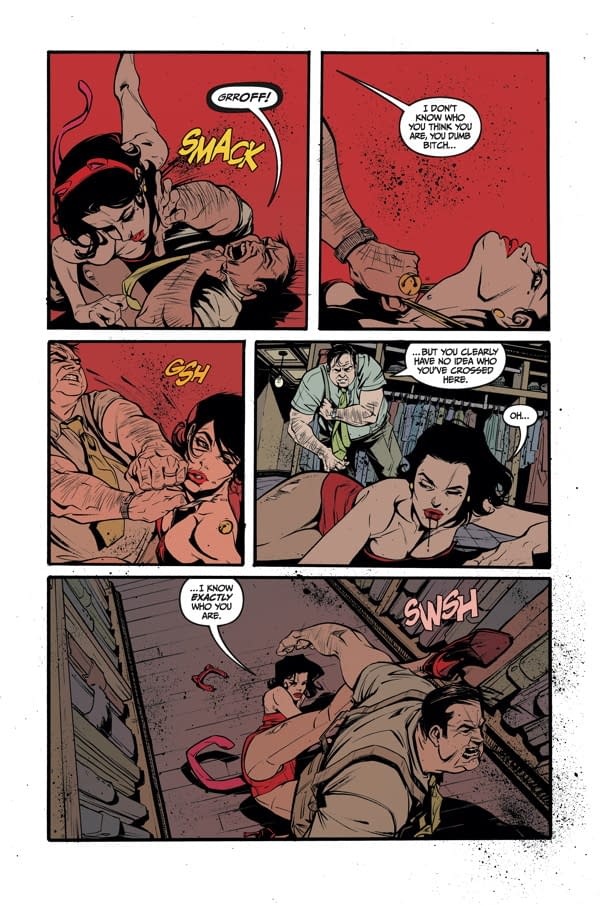
SA: Here's how it's the perfect Dark Horse book: It has that edge of grittiness and crime, as well as amorality that fits, in its own way, our horror line. And it fits alongside Sin City. The number one thing, though, is that it's creators doing a book that only they could do. This is the story that only Joelle could have written and drawn. Joelle has worked with Dark Horse a lot. I think of her as a Dark Horse creator as much as an Oni Press creator. Lady Killer is not a superhero book, but it's a high-concept, character-driven book, the kind of thing that works so well in this medium, with a main character who's very visually distinctive, even if she doesn't have an "S" or a bat on her chest. Joelle has created her own world the same way that Mike Mignola has created a world in Hellboy. We could follow this character the way we follow Hellboy (spoiler alert: she doesn't die in this first arc), maybe even 20 years from now. Tonally, it fits with what we do. Artistically, it belongs right there with what we do. We really respond to being able to follow a creator doing his or her own "perfect" book. Like Matt Kindt doing Mind MGMT. I'm not looking for the next guy who takes a demon and makes him fight monsters. We've got that. We've got Hellboy. We've got Buffy. There is no other book like Lady Killer and now we've got that.
HMS: The Mind MGMT comparison is a really good one on another level, too, because that's a spy book, and for me it seems like there is a strong noir, crime, and even spy element already established at Dark Horse that this fits well with. Like Lobster Johnson.
SA: And Black Beetle. We don't so much chase "retro," but a lot of what we fall in love with is someone taking a classic element and doing it in a very modern way. Black Beetle, in some ways, couldn't be more retro in its subject matter, but it's ultra modern in the way that it's presented. Francesco Francavilla is such a hybrid of classic and modern—there was no one like him in comics 40 years ago, but there should have been. That work actually couldn't have been created until today. Alan Moore wrote a great intro to Hellboy: Wake the Devil, and what he said about Mike Mignola's work, roughly, is that it reminds you of things you read as a kid and things that got you excited about reading, but Mike's book is as good as your memory is of that stuff—whereas when you go back and dig up your favorite book or movie from when you were 11, you might realize it's actually unwatchable. Lady Killer is like that. There was no comic at all like it in 1961, there couldn't have been, but it hearkens to that time while doing things that would've been impossible before 2014, 2015.
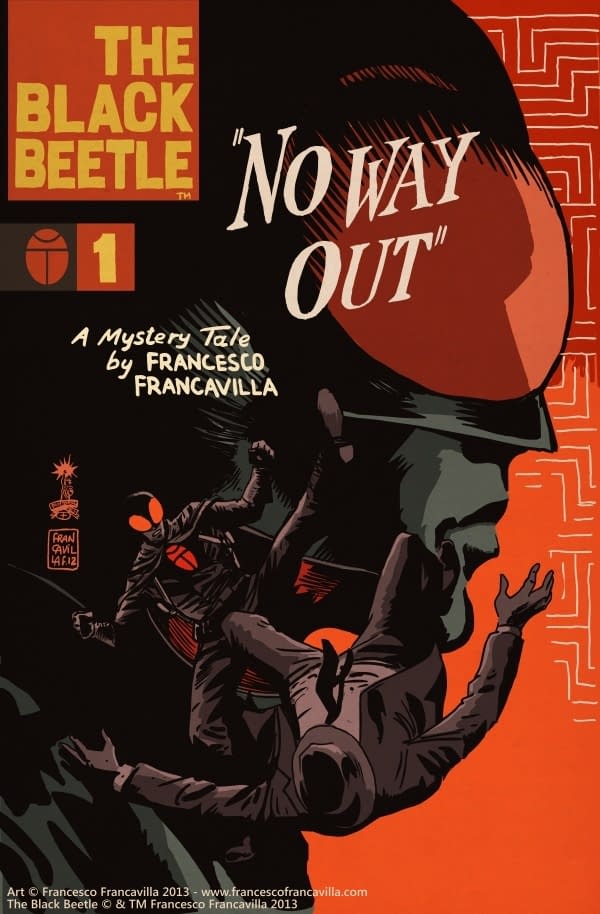
Regarding what you said earlier about this build of books this spring, it reminds me that many of these books were in the wave of announcements at San Diego and of what you said at the time about reminding people that Dark Horse has always been creator-owned.
SA: Yes, and we have a lot of new series to announce soon. For a while, we probably weren't turning the spotlight on the creator-owned stuff enough, even though it was there. Part of that is because we don't segregate and delineate as firmly between those different areas of work. Brian Wood does creator-owned and licensed stuff, and we cross promote those to Brian Wood readers. There was a huge licensing machine behind Star Wars and Brian was very successful on Star Wars. With Conan, it's not the same kind of machine since it started as prose and the work of one person, and for many people, they think of the comic book Conan as the original version of the character. We just love being in the Brian Wood business. We love Brian's comics. So sometimes we neglect to segregate between the books he owns and the ones he doesn't.
In the other direction, not too long ago a journalist I spoke with wasn't aware that The Witcher was a licensed property. He thought it belonged to Paul Tobin because he had seen us promoting Paul so much on the title.

Fight Club 2
HMS: That's funny. I think I had about a half a second quite a while ago when I didn't know that either, but video game people set me straight. When I think of Dark Horse I actually think of a strong presence for video game related titles done to a high quality.
SA: Well, the way we approach licensed comics has always set us apart. Historically, publishers treated licensed books as the red-headed step-child of comics. We're still the guys who more than anyone else will say, "We're not just going to do a Buffy comic, we're going to do Joss's Buffy comic. We're going to do this with him in the best way that we can, to compete with superheroes, using the best artists." We're not just going to lean back and say, "It has a Buffy logo. Kids will buy it." We put everything we have into Mass Effect, Tomb Raider, Halo, all of those books. We tackle those to create the best comic we can without simply relying on built-in fanbases, to make great comics out of them. That's the goal whether we're doing a creator-owned Brian Wood comic or a video game comic by Brian Wood. Make the best Brian Wood comic that we can.
It would have been easy to put just about any artist on Fight Club 2, and sell it based purely on Chuck Palahniuk's name and on the name of the book. But the question was, how do we elevate this beyond that? No one tells comic stories better than Cameron Stewart does and I knew he could bring something to it that would make it even better than what Chuck envisioned. Fight Club is a creator-owned book. I'm sure there are people whose synapses aren't quite firing, who are thinking Fight Club is a licensed book. But Chuck created it and has total control over it.

SA: Fight Club was the first novel Chuck published 20 years ago, and now everyone knows Tyler Durden. It was an extreme, out-there book at the time, and in the 20 years since, Chuck has just gone deeper down the rabbit hole. So with Fight Club 2, coming back to it 20 years later, Chuck brings to bear all he's learned in the meantime. It's a lot crazier in that respect than people might think if they have a dim memory of the movie or book. It'll burn past peoples' expectations.
HMS: Having seen some of the first issue myself, I'd say that it is a wild book already. The prose is so specific and speaks so directly to the reader in a narratorial way, and yet it's very unsettling, because from the very beginning, there's nothing safe about this book. You don't know what's going to happen to any of the characters. For me, introducing a child into that situation just makes me nervous, because it's such an unsafe feeling that Tyler could potentially be around. It's edgy already.
SA: Yeah, it doesn't waste any time. The Free Comic Book Day offering will do an excellent job of recalibrating everyone's memories, if they're not clear on how the book ended. The book and the movie ended a bit differently, though they are very close. David Fincher gave it a more Fincher ending, changing it just a little bit. It's good for folks to read the FCBD story to be reminded where the book ended, to be ready for the sequel.

SA: I couldn't help but Tweet recently that Marla Singer is the worst person. Everyone in this book is terrible. Marla's boredom with her own life causes havoc. She wants a little bit of Tyler Durden. But doesn't everybody? How much Tyler Durden can you really handle?
HMS: I like the phrase "Tyler Durden Lives" because it's also about the impact and the footprint of his effect on their lives afterwards. In a sense, they can never be free of him. It's like a fingerprint on their lives, the aftermath.
Speaking of Cameron Stewart, there's some really impressive design work that ranges from really complex geometric layouts to very open ones. You can really see his toolbox, since he doesn't use really strict geometry that often, but when he wants to, he suddenly breaks into complexity when the narrative needs it.
SA: Yes, he's so inventive and effective. He's been one of my favorites for a long time. Sin Titulo is a masterpiece. I want to see him write more stuff. Cameron is a guy who I'm always asking to write more. I actually don't throw too many scripts his way, because I want to see him do his own thing, but when the opportunity to do Fight Club came up, it was just a good move for everybody.
HMS: We spoke about this in a previous interview, but Cameron and Chuck actually had an unusual back and forth working on this, didn't they?
SA: Yes, this past summer, Cameron actually came here [to Portland] from Berlin to live for the summer in order to work with Chuck. Cameron was here for a few months, and they'd go to Dave Stewart's house and go over the scripts and layouts. We had lots of discussions about what we wanted to do, and about comic book aesthetics. The letterer, Nate Piekos, is an incredible part of the team, as he was on Umbrella Academy. Because of the experience working with Nate and Dave Stewart on Umbrella Academy, I knew that we needed them both on Fight Club. Nate flew out for a week so that we could all spend time together and talk about how we'd use lettering, how we'd use pag layout, and how we'd use color in unique ways. It was really fun, and we established a language to use, and the parameters of what we wanted to do with the book. That was a unique opportunity. Cameron deciding to live here for most of the summer was a great thing for all of us and put us in the right place to be a real team.
HMS: How would you, personally, describe the aesthetics of the comic so far to readers? How does the world of the comic feel to you, artistically?
SA: Well, Chuck and I had been looking for someone who could handle an exaggerated style. I'm sure that other people in my role, when thinking of Fight Club, would've gone in a very different direction. They would have thought that it needed gritty, dark realism. If you've read Chuck's novels, that's not the case. When Gone Girl was coming out, I heard David Fincher being interviewed. He was asked, "Are you ever going to do a comedy?" Without missing a beat, Fincher said, "Fight Club was a comedy." The interviewer thought that was funny, but it was a comedy! So many people don't get that.
There's a strong comic element in everything that Chuck does. It's so grim and dark and it goes so far, some people are too disturbed by the story to notice how funny it is. But Chuck's readers get that, and readers who got into Fight Club as a movie or as a book understand that it's a comedy. Grim artwork would not have carried the story the way Chuck is writing it. The other thing about Chuck's writing that makes Cameron such a perfect fit is that his prose is so punchy. He's a minimalist, to a degree, but he throws these sentences at you, and every one of them just hits like a bullet. He's very precise with imagery and very precise with language. As is Cameron.
The day I met Chuck, he showed up with the complete script. It's changed a lot since then, but I got to read it at that point, before we had a deal in place, and it was such an interesting hybrid of comics script and prose. Chuck throws a line at you, he throws an image at you, in a very driving way. Sometimes it's a really big image, but often it's a small, precise image. One of the aesthetic choices from the get go was that the layouts would be very dense. We didn't want to do a comic where you could read 22 pages in 4 minutes, which is common these days.
We met up recently and looked at Issue 2 together, and Chuck said, "I can't believe how much stuff we fit into 22 pages." So much story comes at you in every issue. And it's 10 issues. The way that Chuck and Cameron are telling this story, they are doing in 10 issues what would've taken 40 issues for some other folks. It's not that it's crammed. Sometimes prose writers, when they move from prose to comics, can't lighten up on the language, so you get these text-heavy comics that don't use art effectively. That is not the case with Fight Club. Chuck leans on the images so hard, and the sequence of the images. We have 9-panel pages, and pages with more than 9 panels, composed of these precise little images. Because Cameron's storytelling is so nuanced, he can nail all the things Chuck is trying to do. To the point that Chuck will go back and strip out some of the dialogue before it's lettered. You're getting comics that work in the most pure sense of the art form, in my opinion.
Silent storytelling is a very difficult thing. Some artists just can't do it. Some knock it out of the park, some can't do it. Chuck and Cameron have a number of silent sequences that work well because Chuck is great at selecting an image and Cameron just cannot fail at creating the flow on the page that takes you through it in this incredibly graceful way.
HMS: Can you tell us anything about the release date for Fight Club?
SA: Yes. It's May 27th. The good news for retailers is that FOC is the Monday after Free Comic Book Day, and as I mentioned, FCBD this year features a 14 page retelling of the end of the novel by Chuck and Cameron. We're getting a lot of support from Chuck's book publisher, Random House, since he has a short story collection coming out the day before the first issue. It'll help give the launch a lot of visibility, and we hope we'll get a lot of new customers into stores. The Random House book is called Make Something Up. It's got a short story that ties in with Fight Club. Chuck writes in a very different voice on that story, and it's very fun and weird. It doesn't connect directly with what we're doing, but it's very cool.

SA: It's 10 issues, which we'll do in one giant hardcover, rather than doing a couple trades. It'll be a beautiful book. Many issues are more than 22 pages, so the hardcover will be 10 issues of that and a fair amount of cool ancillary material that we'll be including.
HMS: Do you get the sense that comics are something that Chuck will now consider doing in the future because he's become so immersed in comics through doing this? I know you said in the past that he took researching the form and its strengths really seriously.
SA: We've talked about other stuff he might do next, though we haven't nailed anything down. I don't foresee him writing a run on Hellboy, although that would be pretty interesting (laughter). He's done a great job of recognizing the potential in the artform and he's done something unusual with it.
HMS: Will Fight Club 2 be a presence at conventions this year?
SA: Chuck will be coming to some conventions with us this year. One of the reasons he got into comics was an interest in comics culture and conventions, as well as hanging out with other comic creators and talking about graphic novels. He's seen something that he likes in our community and wants to plug into it.
Ei8ht
HMS: That's a nice vote of confidence! Can we talk about this new series Ei8ht a little? I've actually seen the first 3 issues. Rafael Albuquerque is blowing my mind. I can't believe how ingenious the color scheme idea in it is, using different baseline colors for different time-lines to keep the reader on track. It's just astonishing.
SA: I know. Rafael is a master, and he knows exactly what he's doing with this series. Comics have unlimited potential for this kind of thing visually complex sci fi saga. One thing I find remarkable about his art is how much he uses white, especially on covers. So it's not just the color scheme you're talking about that's impactful. He uses different colors for the Past, Present, Future, and the "Meld," but it's also his heavy use of white to balance those poster-like colors. It doesn't look like anything else—no one could have done this but him.
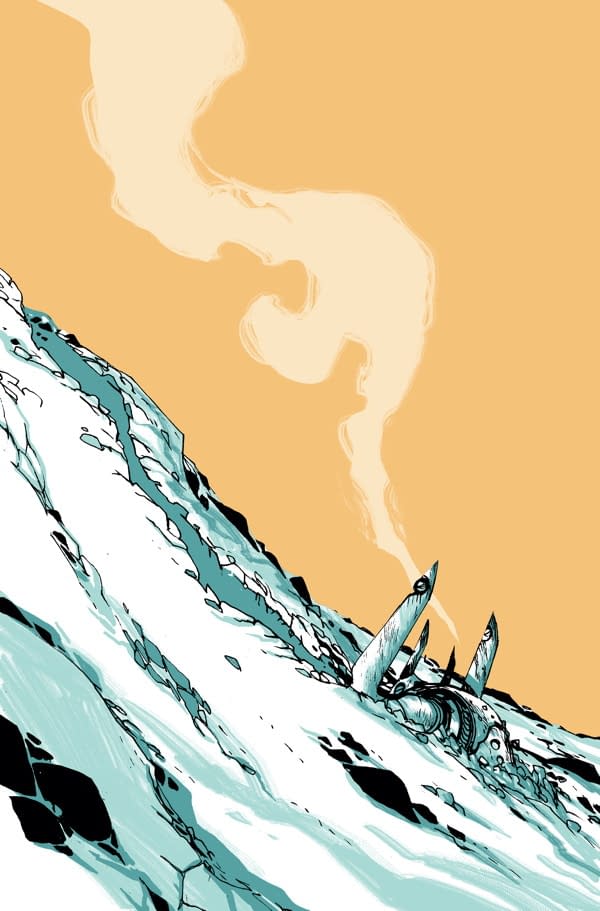
SA: Another unsung hero who I mentioned before is Nate Piekos, who is also the letterer on this book. He doesn't do it for every book, but for quite a few he comes in and invents a whole lettering vocabulary for a given title. That's why I wanted him on Fight Club. When I read the first issue of Ei8ht, it had a special quality to it that gives the book even more personality in each of its parts. Nate has done that on so many books, from Umbrella Academy to the Alien: Fire and Stone stuff, to working with Richard Corben. It's incredible working with a guy like him.
HMS: He's at top of his field and his game, he really is. Were you the one who received the pitch for Ei8ht? How did it strike you?
SA: Sierra Hahn is the editor on that and was the one who brought that in. And she just raved about it. We trust Sierra, and we'd worked with Rafael before. I think it was pitched to us as a sci-fi and time-travel thing. That was all we needed to hear.
HMS: It's visually surprising, with interesting narrative flow. It also reminds me again that sci-fi is really at home with Dark Horse. And this is a great flag waving as a reminder.
SA: For me, it's the best kind of sci-fi because it really digs into some ideas and goes to speculative places. The simplest form of sci-fi reads: if there are aliens and space ships and robots, then it's sci-fi. But if it doesn't deal with ideas, is it really doing what sci-fi is capable of? Horror is the same. If you just have monsters running around punching each other (laughter), you're dealing with the tropes of horror without really getting at what the genre can do to give you an experience.
The Goon: Once Upon a Hard Time
HMS: What's going on with The Goon? I hear ominous things about the series in the future maybe not even being called The Goon? I talked with Eric Powell awhile back about "Occasion of Revenge" and I know he made some Reddit announcements around the holiday season.
SA: Yes. Occasion of Revenge set up the framework for a tragic turn of events and it's the events of that book that put the Goon in a dark place. Part of how I perceive real tragic storytelling, classical tragedy, is that we don't always act in our best interest, especially when we've been pushed to the edge. Sometimes being pushed to the edge creates a great hero who rises above everything, but sometimes we get our heart torn out, and our friends get beaten down, and our judgment crumbles. In Occasion of Revenge, the Goon went to a violent, dark place and that's where we find him in Once Upon a Hard Time.
The first issue of Once Upon a Hard Time ends on such a sour note, and there's a fight bearing down on Goon that could change everything. What's actually going on inside of Goon might be the darker truth to face. There's a big panel on the last page of Once Upon a Hard Time, and it's a close-up on Frankie, who's of course this silly a riff on a Little Orphan Annie-like character. But the look on his face in that panel is so tragic and upsetting, you know readers are in store for something. This arc resolves everything that's been hanging over Goon's head since the series launched many years ago. It's all coming down now. Eric said on Reddit recently that after this, the book that he does might not even be called The Goon.
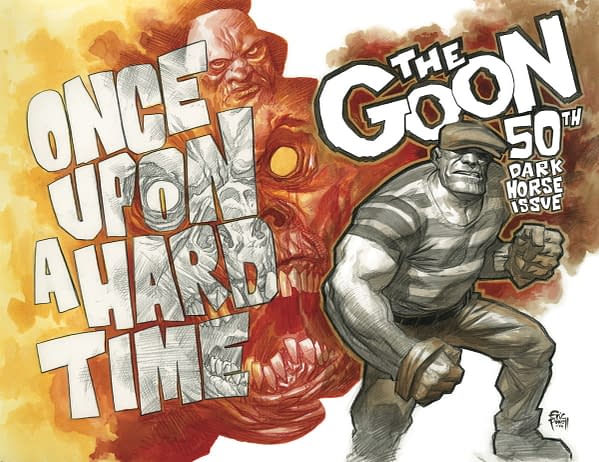
SA: Well, he'll continue with this world and these ideas, some of these characters—this isn't the end of everything—but it is the resolution of a story that he's been telling since before 2003. What comes next will be different by necessity because of what happens here.
HMS: Eric really pulls out all the stops on the artwork of that first issue. It's like all the characters are sculpted out of marble—it's amazing.
SA: His extremely limited color scheme is so weird and moody. He's doing a poster-like approach with color, throwing color into word balloons, to get these graphic pops. Goon is drinking a lot and in the first issue, he starts to take things out on his friends, and mangles someone. It's going to a dark place, indeed.
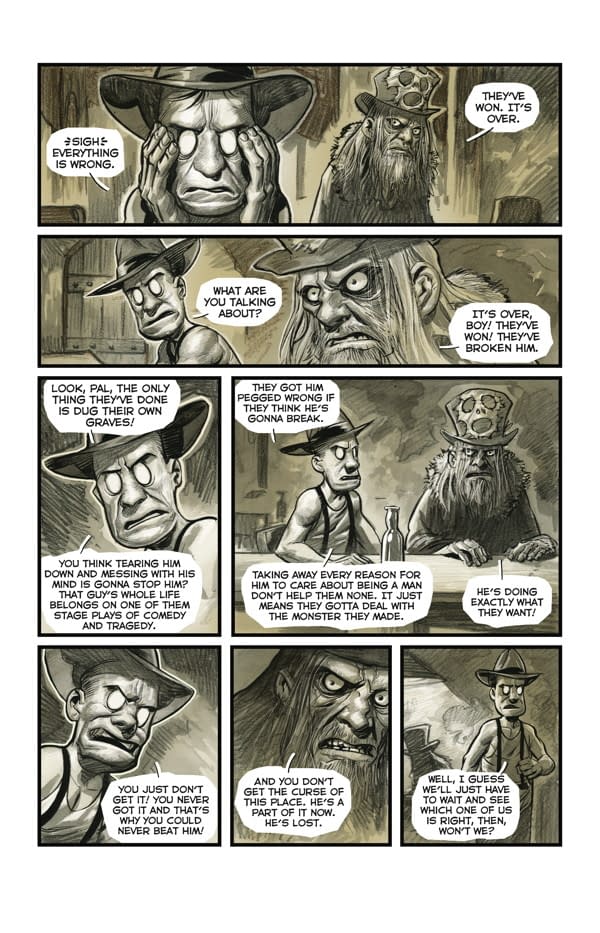
Rebels
HMS: What about this new series, Rebels? It's not that common for Dark Horse to do a purely history-based series, is it?
SA: Brian Wood has a lot of different interests, and this book will be unlike anything else. Brian looks at important issues and ideas. He looks at conflict in this world and how it affects people. He's bringing an important time in American history—our revolution—to life here in a really accesible way. It's not a history lesson—it's a fight, a struggle. My ancestors have been in the States since the 1630s and a little earlier. When we were kids, we talked about ancestors involved in the conflicts Brian's bringing to life in a way that people haven't seen before.
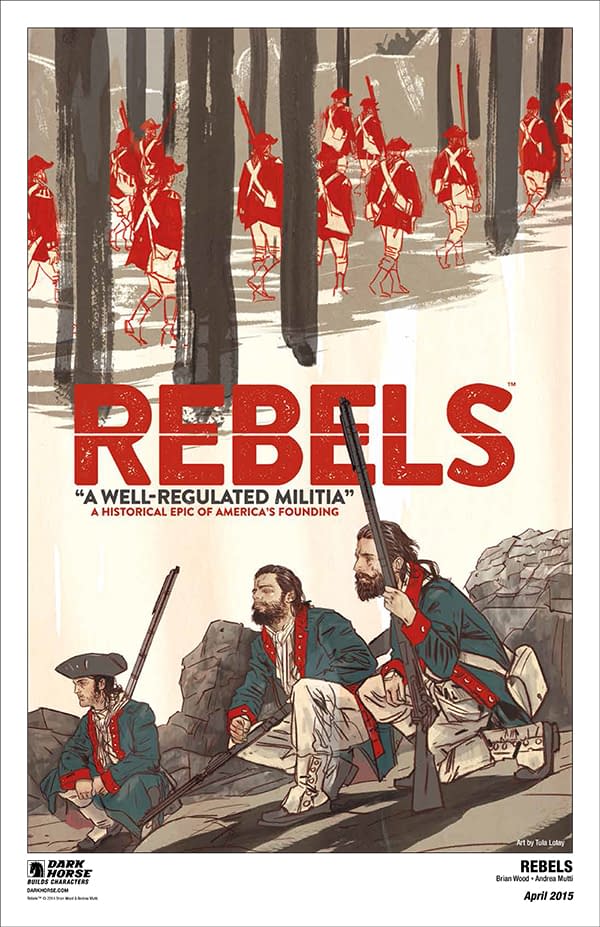
SA: And he's paired with Andrea Mutti, who has done a lot of stuff with us over the years, but this is such a great use of his abilities. He makes it all real and relatable, personal. Comics are the perfect medium for this kind of thing. This is somewhat like what they do with comics in Europe, so it makes sense that we're working with a European artist.
HMS: You can't get much more American with the subject matter! I can already see a really interesting idea developing about American identity in the comic, and it's not exactly what you might expect. It's not a cliché. Brian is interrogating what it means to be American.
SA: Can we quote you on that? That's a great way to say what Brian does a lot of the time. He interrogates what it means to live in this world. He takes a timeless approach to these things, whether it's The Massive, or DEMO, or Star Wars. This is another book that nobody else would have done, the best example of creator-owned.
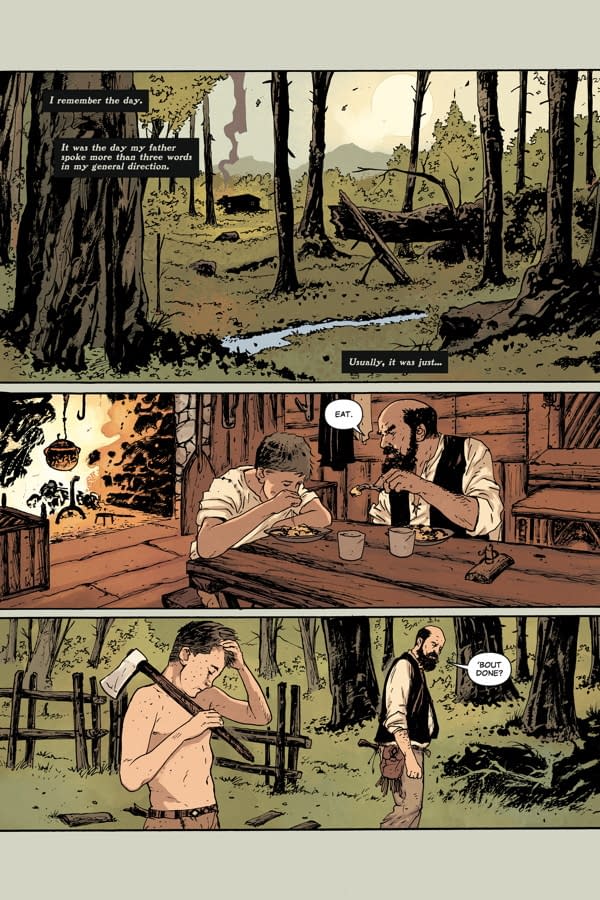
SA: That's typical of comics right now. Typical in a good way! We don't need to do the comics we grew up on. You can go to new places. Rebels, PastAways, Black Hammer, Fight Club 2, are all examples of making the art form more exciting. These are things that never could've existed when I was a kid.
HMS: Even a few years ago, you could predict to some extent predict what you'd see on shop shelves. Now there's no way you could really have predicted the swath of beautiful, interesting books that people are producing. Everything is a brand new experience now.
SA: It's an exciting time to be in comics and reading comics. The store I go to, Excalibur in Portland, is always turning me on to books I haven't heard about.
Past Aways
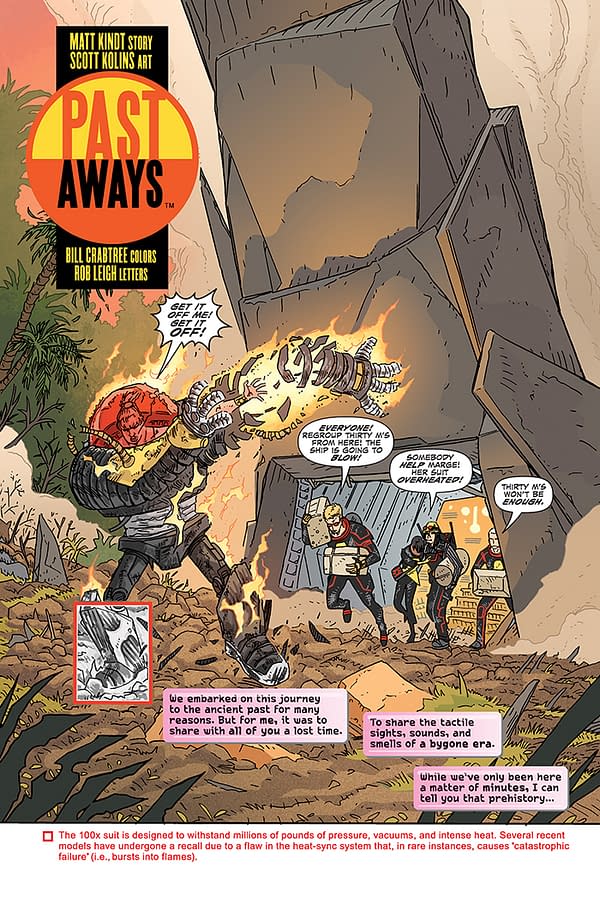
SA: Matt Kindt is another guy like Brian, who's become a big part of what we do. Mind MGMT has been a critical darling, so when he pitched this to us, another time-traveling sci-fi story with a heavy adventure vibe to it, we were all psyched. Scott Kolins is someone I'd only worked with once a long time ago, and when I saw the unlettered pages for #1, I was amazed. Every page is crammed with sci-fi ideas in a kind of rollicking, intense adventure style. It's great to see Matt paired up with a very different kind of artist who normally he might have only worked with on Justice League or something. I love a comic full of crazy ideas and imagery.
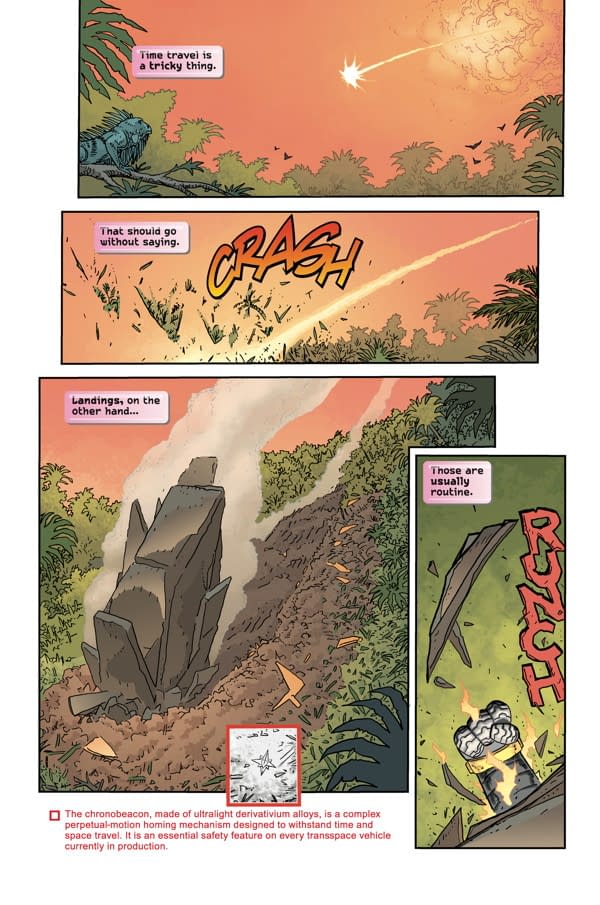
SA: There's the lovely image of a full-page of a guy sitting on the toilet looking at his iPad. There's sophisticated humor here, but there's a lot of in your face humor too.
Rat God
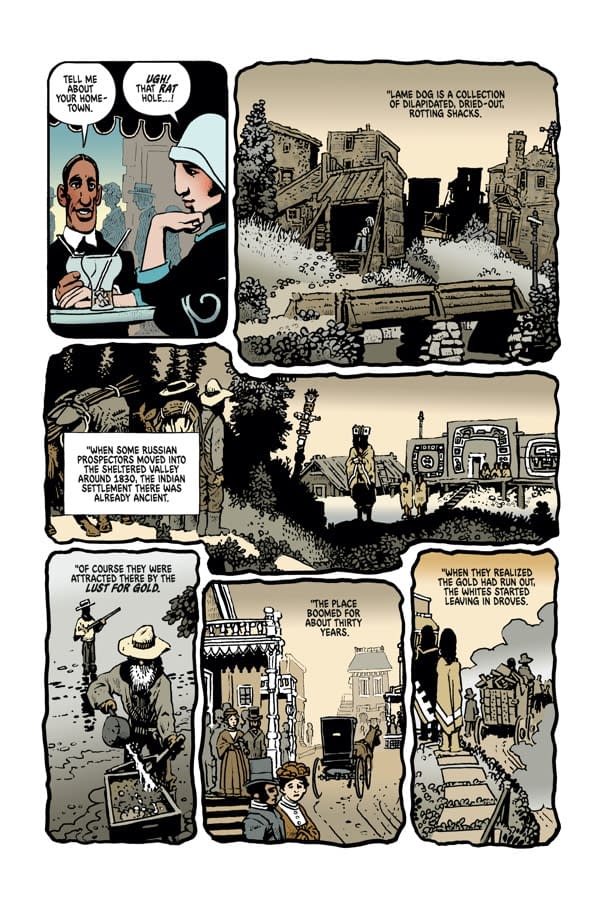
SA: After he had done the Poe adaptations for us, I said, "What next?" and he was thinking H.P. Lovecraft adaptations. I'm a big Lovecraft fan, but I don't feel his stories adapt as well as Poe's stories. I also wanted to see Corben write his own stuff, so I suggested he take his favorite ideas from Lovecraft and write a longer arc of his own. Now if I've cheated the world of seeing Richard Corben do Shadow over Innsmouth, then I'm probably a bad person (laughter). But seeing him do his own thing with Rat God is more exciting to me, as a reader. He gave us something really original, and it wasn't the typical choice of Lovecraft elements. No tentacles or octopus monsters, but the most unnerving ideas of Lovecraft.
His artwork gets better all the time, too. Seeing him do this book is a career highlight for me. He's been a hero of mine since I was a little kid, but seeing him with free reign at this period of his career is beautiful. You and I were talking before about horror and sci-fi comics not embracing everything those genres are capable of, but Rat God sure as shit does. It makes you wonder what's real, and gives you imagery that's not about splattering blood, but creating characters who make you legitimately uncomfortable. That's on full display in this book. His protagonist is a very Lovecraftian character, and he's among a bunch of inbred rat-people. Way to go, Corben!
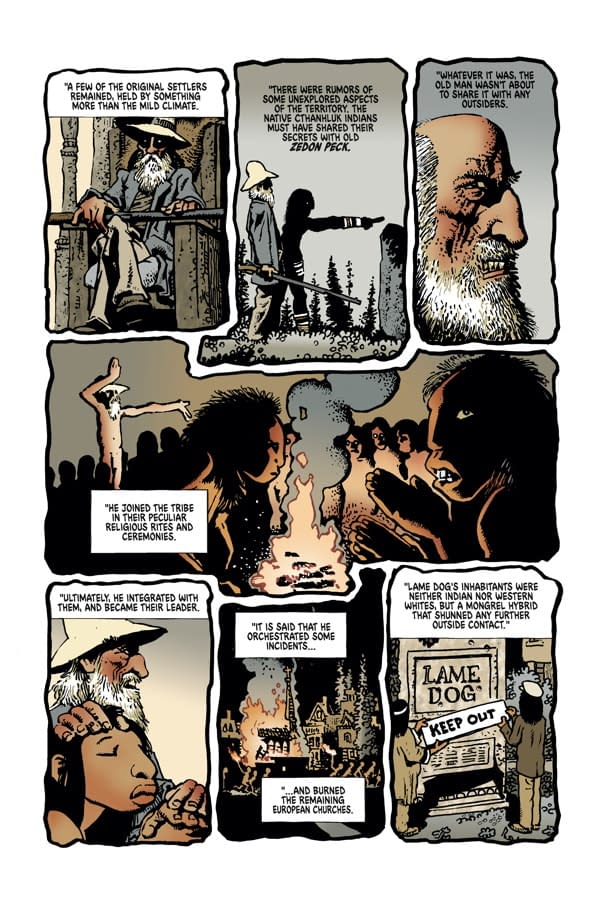
SA: He gets even more detailed as the series progresses, rather than losing steam. There's nothing about this guy that slows down.
Abe Sapien #23 drawn by Kevin Nowlan

SA: Working on Abe Sapien, we occasionally have these stand-alone issues that jump back into the past. We've been working on issue #23 for a while. I get to work with someone who's been an art-hero for me since the early '90s. We've been lucky enough to have Kevin come in occasionally to do a Hellboy one-shot, and now we get him on Abe. There was a panel in Hellboy: Box Full of Evil, a flashback, where Hellboy talks about how tough Abe is. He says one time they were in British Columbia investigating lake monsters and Abe got thrown 50 feet onto some sharp rocks and had to go to the hospital, but was okay afterwards. Mignola drew one panel of Abe flying through the air in that story. When Kevin told me what he was interested in drawing for the one shot, I flashed back to that story, and realized this was the place to tell it. Mike and I got the story together, with Hellboy and Abe in the early 90's in British Columbia. Kevin drew it, inked it, lettered it, did the cover, the whole thing. Thse comics with Kevin are some of the only comics we do that Dave Stewart doesn't color—we're all happy to defer to Kevin Nowlan. To see Kevin draw some classic Hellboy in the middle of the Abe series is great.
Frankenstein Underground, Hellboy in Hell #7 and #8
HMS: There are so many hints about things that have happened in the Hellboy universe that have never been told, that things just expand over time.
SA: That's part of the plan with how we do these books, intentionally putting in little hints, little buds on a branch, and we don't know which ones are going to flower. Like Varvara. She was a character we didn't think was going to be a big deal when we created her in B.P.R.D. 1946. We had no idea how important she'd be, but artists loved to draw her. John or Mike would then think of ways to use her, and the next thing you knew, she'd taken on massive significance. And she is going to be even more significant character going forward. It happens organically, not all by careful design—though there is some planning…
That's how Frankenstein Underground came about. We did the House of the Living Dead graphic novel with Richard Corben. It was Mike's chance to throw the Universal-style characters into one story, but do it at a mad scientist's lab in Mexico. You've got a werewolf, a vampire, and a Frankenstein's monster that Mike and Corben designed together. Of all the characters in that book, the monster survived and wandered into the desert. Mike says that at that time he didn't know this was the "actual" Frankenstein's Monster from literature. But Mike has had a lot of fun creating stories set in Mexico, so it felt good to go back to that.
The first thing Mike told me about Frankenstein Underground made it sound like it was going to be this inconsequential monster rampage. But one of the things I love about Mike's work is the tension between the dumb guy action and the more contemplative stuff. Whenever he feels himself having gone too far in one direction, he goes in the other direction. Frankenstein Underground could have just been a monster romp, but he felt the need to put something more deeply engaging in it, so the story has taken on a lot more, says more about Mike's world, and where things are heading … It's a Journey to the Center of the Earth-style monster romp, with history's greatest monster, at the same time exploring some of the weirdest corners of Mike's mythology.
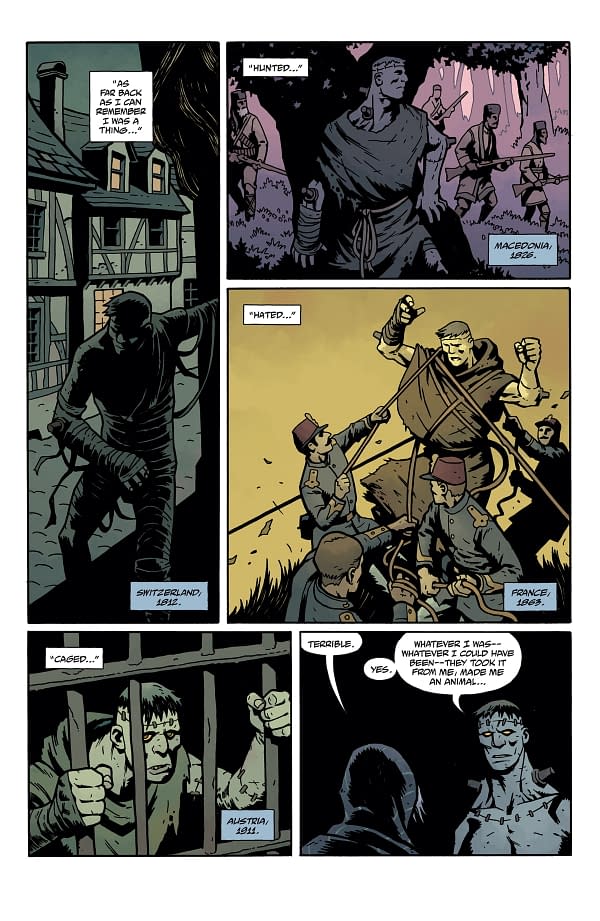
SA: I know exactly what you're saying. The ultimate version of the "leash" for Mike is actually the B.P.R.D.—the organization, not the book … When he created Hellboy, and made him work for a government organization, that limited Mike in certain ways. It set the story in the real world in a way that's not really where Mike's brain goes. So much of what he's done in the last ten years has been about getting off the leash. If you go back to the collection Strange Places, with two of the most difficult stories Mike ever created, "The Third Wish" and "The Island," those stories were about taking Hellboy away from the real world with its cars and its guns. They put Hellboy deep into a mythological world where Mike can creates anything he wants.
Hellboy in Hell is the ultimate version of Mike going wherever he wants. Frankenstein Underground, similarly, creates a world where Mike can do anything he wants. The nice thing is that the stuff that Mike finds interesting makes for incredibly entertaining comics. Frankenstein Underground delves into key secrets of the Hellboy universe, but it's most satisfying as a stand-alone, bizarre story about a monster with philosophical overtones. Mike takes the monster and some of the ideas from the Mary Shelley novel, then goes full tilt in a direction only he would go. It's unchained and unbridled, and it's set in the center of the earth where no one can tell Mike what to do.
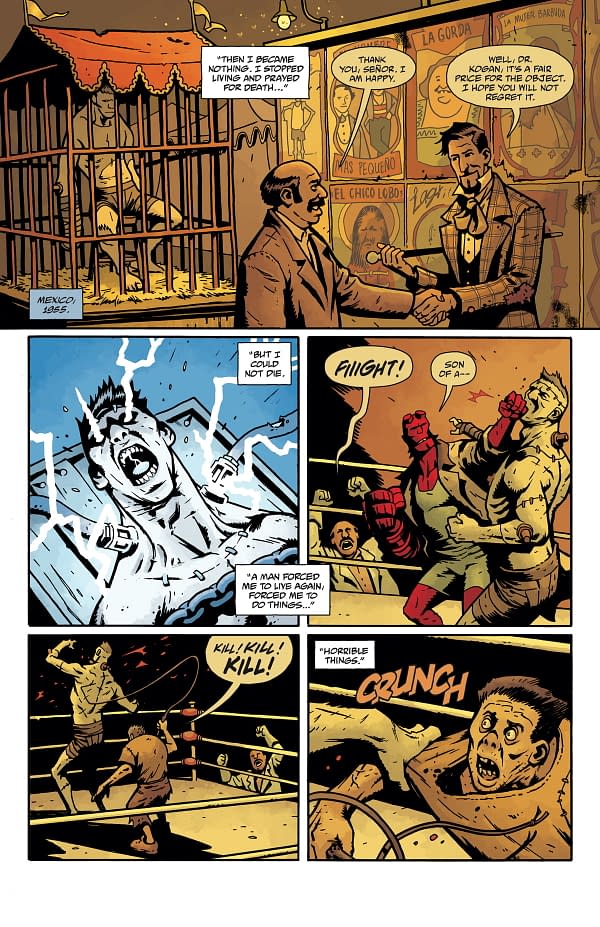
Now, speaking of Hellboy in Hell, when is that coming back?
SA: Yes. Mike finished Issue #7 and is nearly done with #8. They're coming out in August in September, two issues in consecutive months. Mike wants to make sure the books never ship late, so he makes sure they are nearly done before we solicit.
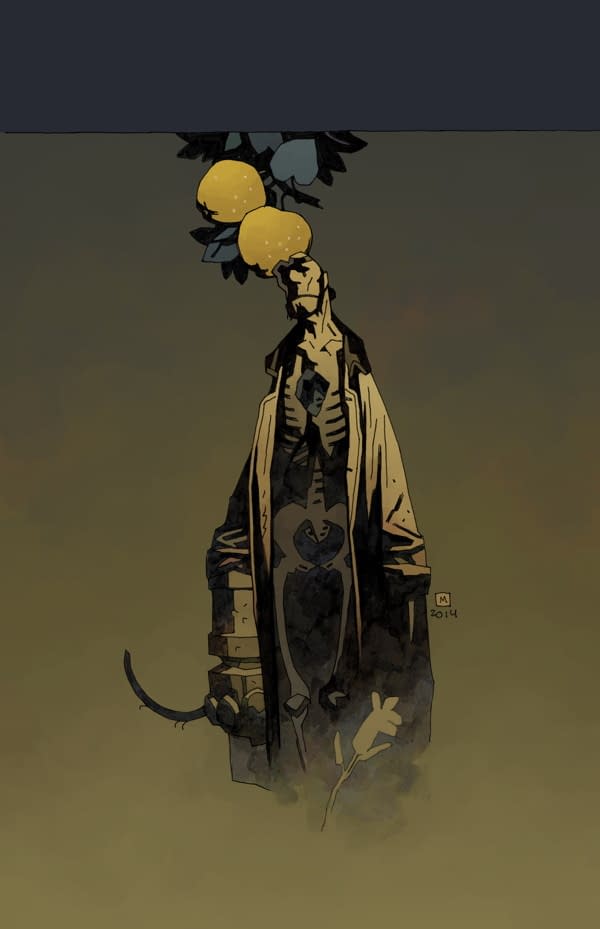
Baltimore: The Cult of the Red King
HMS: What's going on in the Baltimore universe?
SA: The new series, which we just announced this week, The Cult of the Red King, takes us into the big final act of Baltimore. The Baltimore stories work in two big chunks. The first four hardcovers preceded the events of the novel by Mike and Christopher Golden. The fourth volume resolved a big plot-point. The vampire who began this plague of evil across Europe and killed Baltimore's family was the longtime object of Baltimore's revenge, and Baltimore finally got it. In the wake of the death of the vampire, the real evil behind this plague of monsters is revealed as a much deeper, more evil personality known as The Red King. His cults of worship have popped up across Europe, and nobody is even sure if he's real. In the first four volumes, Baltimore took on Mike's perverse version of Dracula, then managed to kill him. Volume 5 kind of re-set Baltimore, as he got his feet under him. The new series kicking off this spring defines Baltimore's greater purpose. First he defeated Dracula, but now he has to figure out if Satan exists, and then go after him.
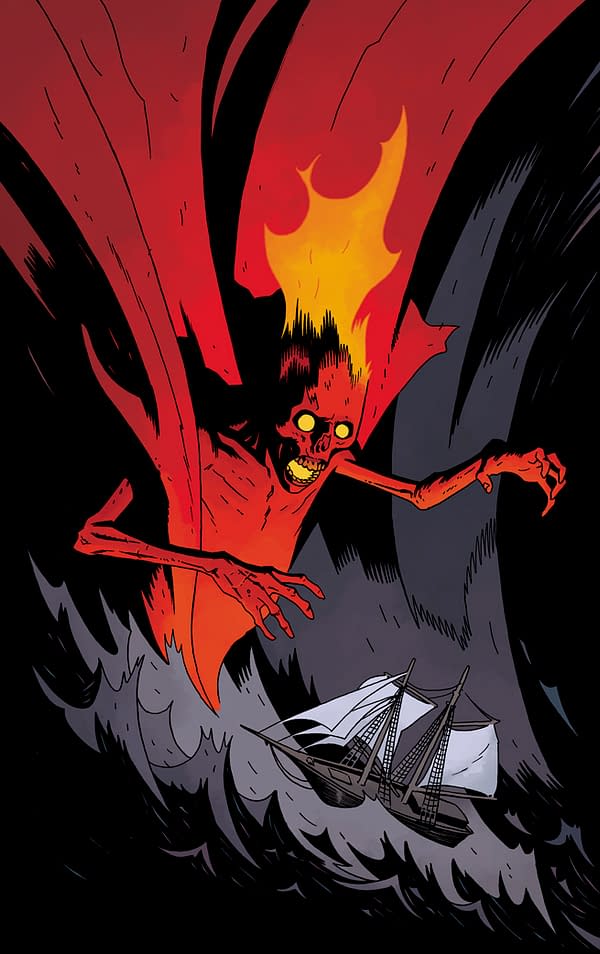
SA: Yeah. In real-world mythological terms, the best correlation to the Red King is the Devil. Baltimore will start with his worshipers, to see if he can get to him and end this damnation and suffering. Baltimore and his crew go up against the most evil people they can find in the hopes of confronting a bigger power of evil. Across the next few volumes, Baltimore will sacrifice everything to go up against the weirdest stuff that Mike and Chris Golden can think up to throw at them.
You can find out more about the recently announced Baltimore: The Cult of the Red King here.
Lady Killer #2 arrived this week and you can find out more about it here.
Pastaways is arriving on March 25th and is currently listed in Previews World with item code: JAN150085
Ei8ght is arriving on February 18th and is currently listed in Previews World with item code: DEC140095
Rat God #1 arrived this week. You can find out more about it here.
Rebels arrives April 8th and is currently listed in Previews World with item code: FEB150008
The Goon: Once Upon A Hard Time arrived this week. Find out more about it here.
Frankenstein Underground arrives on March 25th and is currently listed in Previews World with item code: JAN150084


